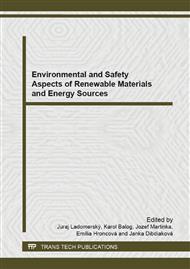p.300
p.306
p.312
p.318
p.324
p.330
p.336
p.342
p.350
Hazards of Explosibility Dust from Wood Pellets
Abstract:
The main purpose of this publication is to determine minimal ignition temperature of dust cloud. The flammable and explosive dust is formed during the production, transport, storage and usage of the wood pallets. The examined samples in experimental part of the work were made from different kind of pallets. Contribution deals with analysis of fire and explosion hazards of dust particles generated during transportation and handling of wood pellets. Minimum ignition temperature of dust cloud were performed according to STN EN 50281-2-1. In terms of forensic approach, by using of selected methods, the conditions in which initiation and explosion of dust can be occurred were simulated the exposibility for wood pellets dust was tested under different condition using various pressures and various weight to samples. Defining the conditions in which the risk of formation of dangerous situation exists, helps to predict the fire and explosion in the premises where the pellets are used.
Info:
Periodical:
Pages:
324-329
Citation:
Online since:
August 2014
Authors:
Price:
Сopyright:
© 2014 Trans Tech Publications Ltd. All Rights Reserved
Share:
Citation:


